Livestock


Livestock are the domesticated animals raised in an agricultural setting in order to provide labour and produce diversified products for consumption such as meat, eggs, milk, fur, leather, and wool. The term is sometimes used to refer solely to animals who are raised for consumption, and sometimes used to refer solely to farmed ruminants, such as cattle, sheep, and goats.[1] Horses are considered livestock in the United States.[2] The USDA classifies pork, veal, beef, and lamb (mutton) as livestock, and all livestock as red meat. Poultry and fish are not included in the category.[3] The latter is likely due to the fact that fish products are not governed by the USDA, but by the FDA.
The breeding, maintenance, slaughter and general subjugation of livestock, called animal husbandry, is a part of modern agriculture and has been practiced in many cultures since humanity's transition to farming from hunter-gatherer lifestyles. Animal husbandry practices have varied widely across cultures and time periods. It continues to play a major economic and cultural role in numerous communities.
Livestock farming practices have largely shifted to intensive animal farming.[4] Intensive animal farming increases the yield of the various commercial outputs, but also negatively impacts animal welfare, the environment, and public health.[5] In particular, beef, dairy and sheep are an outsized source of greenhouse gas emissions from agriculture.
Etymology
[edit]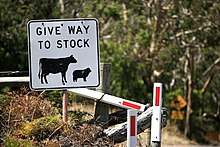
The word livestock was first used between 1650 and 1660, as a compound word combining the words "live" and "stock".[6] In some periods, "cattle" and "livestock" have been used interchangeably. Today,[specify] the modern meaning of cattle is domesticated bovines, while livestock has a wider sense.[7]
United States federal legislation defines the term to make specified agricultural commodities eligible or ineligible for a program or activity. For example, the Livestock Mandatory Reporting Act of 1999 (P.L. 106–78, Title IX) defines livestock only as cattle, swine, and sheep, while the 1988 disaster assistance legislation defined the term as "cattle, sheep, goats, swine, poultry (including egg-producing poultry), equine animals used for food or in the production of food, fish used for food, and other animals designated by the Secretary".[8]
Deadstock is defined in contradistinction to livestock as "animals that have died before slaughter, sometimes from illness or disease". It is illegal in many countries, such as Canada, to sell or process meat from dead animals for human consumption.[9]
History
[edit]Animal-rearing originated during the cultural transition to settled farming communities from hunter-gatherer lifestyles. Animals are domesticated when their breeding and living conditions are controlled by humans. Over time, the collective behaviour, lifecycle and physiology of livestock have changed radically. Many modern farmed animals are unsuited to life in the natural world.
Dogs were domesticated early; dogs appear in Europe and the Far East from about 15,000 years ago.[10] Goats and sheep were domesticated in multiple events sometime between 11,000 and 5,000 years ago in Southwest Asia.[11] Pigs were domesticated by 8,500 BC in the Near East[12] and 6,000 BC in China.[13] Domestication of horses dates to around 4,000 BC.[14] Cattle have been domesticated since approximately 10,500 years ago.[15][specify] Chickens and other poultry may have been domesticated around 7,000 BC.[16]
Types
[edit]The term "livestock" is indistinct and may be defined narrowly or broadly. Broadly, livestock refers to any population of animals kept by humans for a useful, commercial purpose.
| Animal | Ancestor | Domestication | Utilization | Picture | |
|---|---|---|---|---|---|
| Horse | Tarpan | Eurasia | Riding, racing, carrying and pulling loads, meat, milk | 
| |
| Donkey | African wild ass | Africa | Carrying loads and draught | 
| |
| Cattle | Eurasian aurochs | Eurasia | Meat, milk and draught | 
| |
| Zebu | Indian aurochs | Eurasia | Milk, meat and draught | 
| |
| Bali cattle | Banteng | SE Asia | Meat, milk and draught | 
| |
| Yak | Wild yak | Tibet | Pack animals, milk, meat and hide | 
| |
| Water buffalo | Wild water buffalo | India and SE Asia | Meat, milk and carrying loads | 
| |
| Gayal | Gaur | India and Malaysia | Carrying loads and draught | 
| |
| Sheep | Mouflon | Iran and Asia Minor | Meat, milk and fleece. | 
| |
| Goat | Bezoar ibex | Greece and Pakistan | Meat, milk and fleece | 
| |
| Reindeer | Reindeer | Eurasia | Draught, milk, flesh and hide | 
| |
| Bactrian camel | Wild Bactrian camel | Central Asia | Riding, racing, meat, milk and fur | 
| |
| Arabian camel | Thomas' camel | North Africa and SW Asia | Riding, racing, meat and milk | 
| |
| Llama | Guanaco | Andes | Pack animals, meat, fleece | 
| |
| Alpaca | vicuña | Andes | Meat, fleece | 
| |
| Domestic Pig | Wild boar | Eurasia | Meat, Companionship, truffle hunting | 
| |
| Domestic Dog | Wolf | Eurasia and North America | Companionship, hunting | 
| |
| Domestic Cat | African wildcat | Near East | Companionship, mousing, vibration therapy | 
| |
| Chicken | red junglefowl | Southeast Asia | Meat, egg | 
|
|
| Rabbit | European rabbit | Europe | Meat, wool | 
| |
| Guinea pig | Montane guinea pig | Andes | Meat | 
|
Micro-livestock
[edit]Micro-livestock is the term used for much-smaller animals, usually mammals. The two predominant categories are rodents and lagomorphs (rabbits). Even-smaller animals are kept and raised, such as crickets and honey bees. Micro-livestock does not generally include fish (aquaculture) or chickens (poultry farming).
Farming practices
[edit]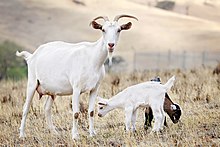
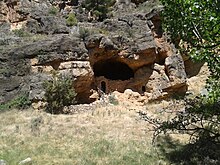
Traditionally, animal husbandry was part of the subsistence farmer's way of life, producing not only the food needed by the family but also the fuel, fertiliser, clothing, transport and draught power. Killing the animal for food was a secondary consideration, and wherever possible their products, such as wool, eggs, milk and blood (by the Maasai) were harvested while the animal was still alive.[17]
In the traditional system of transhumance, humans and livestock moved seasonally between fixed summer and winter pastures; in montane regions the summer pasture was up in the mountains, the winter pasture in the valleys.[18]
Animals can be kept extensively or intensively. Extensive systems involve animals roaming at will, or under the supervision of a herdsman, often for their protection from predators. Ranching in the Western United States involves large herds of cattle grazing widely over public and private lands.[19] Similar cattle stations are found in South America, Australia and other places with large areas of land and low rainfall. Ranching systems have been used for sheep, deer, ostrich, emu, llama and alpaca.[20] In the uplands of the United Kingdom, sheep are turned out on the fells in spring and graze the abundant mountain grasses untended, being brought to lower altitudes late in the year, with supplementary feeding being provided in winter.[21]
In rural locations, pigs and poultry can obtain much of their nutrition from scavenging, and in African communities, hens may live for months without being fed, and still produce one or two eggs a week.[17] At the other extreme, in the more Western parts of the world, animals are often intensively managed; dairy cows may be kept in zero-grazing conditions with all their forage brought to them; beef cattle may be kept in high density feedlots;[22] pigs may be housed in climate-controlled buildings and never go outdoors;[23] poultry may be reared in barns and kept in cages as laying birds under lighting-controlled conditions. In between these two extremes are semi-intensive, often family-run farms where livestock graze outside for much of the year, silage or hay is made to cover the times of year when the grass stops growing, and fertiliser, feed and other inputs are bought onto the farm from outside.[24]
Predation
[edit]Livestock farmers have often dealt with natural world animals' predation and theft by rustlers. In North America, animals such as gray wolves, grizzly bears, cougars, and coyotes are sometimes considered a threat to livestock. In Eurasia and Africa, predators include wolves, leopards, tigers, lions, dholes, Asiatic black bears, crocodiles, spotted hyenas, and other carnivores. In South America, feral dogs, jaguars, anacondas, and spectacled bears are threats to livestock. In Australia, dingoes, foxes, and wedge-tailed eagles are common predators, with an additional threat from domestic dogs who may kill in response to a hunting instinct, leaving the carcass uneaten.[25][26]
Disease
[edit]Good husbandry, proper feeding, and hygiene are the main contributors to animal health on farms, bringing economic benefits through maximised production. When, despite these precautions, animals still become sick, they are treated with veterinary medicines, by the farmer and the veterinarian. In the European Union, when farmers treat the animals, they are required to follow the guidelines for treatment and to record the treatments given.[27]
Animals are susceptible to a number of diseases and conditions that may affect their health. Some, like classical swine fever[28] and scrapie[29] are specific to one population of animals, while others, like foot-and-mouth disease affect all cloven-hoofed animals.[30] Where the condition is serious, governments impose regulations on import and export, on the movement of livestock, quarantine restrictions and the reporting of suspected cases. Vaccines are available against certain diseases, and antibiotics are widely used where appropriate.
At one time, antibiotics were routinely added to certain compound foodstuffs to promote growth, but this is now[specify] considered poor practice in many countries because of the risk that it may lead to antibiotic resistance.[31] Animals living under intensive conditions are particularly prone to internal and external parasites; increasing numbers of sea lice are affecting farmed salmon in Scotland.[32] Reducing the parasite burdens of livestock results in increased productivity and profitability.[33]
According to the Special Report on Climate Change and Land, livestock diseases are expected to get worse as climate change increases temperature and precipitation variability.[34]
Transportation and marketing
[edit]
Since many livestock are herd animals, they were historically driven to market "on the hoof" to a town or other central location. The method is still used in some parts of the world.[35]
Truck transport is now common in developed countries.[36]
Local and regional livestock auctions and specialized agricultural markets facilitate trade in livestock. In Canada at the Cargill slaughterhouse in High River, Alberta, 2,000 workers process 4,500 cattle per day, or more than one-third of Canada's capacity. It closed when some of its workers became infected with coronavirus disease 2019.[37][38] The Cargill plant together with the JBS plant in Brooks, Alberta and the Harmony Beef plant in Balzac, Alberta represent fully three-quarters of the Canadian beef supply.[38] In other areas, livestock may be bought and sold in a bazaar or wet market, such as may be found in many parts of Central Asia.
In non-Western countries, providing access to markets has encouraged farmers to invest in livestock, with the result being improved livelihoods. For example, the International Crops Research Institute for the Semi-Arid Tropics (ICRISAT) has worked in Zimbabwe to help farmers make their most of their livestock herds.[39]
In stock shows, farmers bring their best livestock to compete with one another.[40]
Biomass
[edit]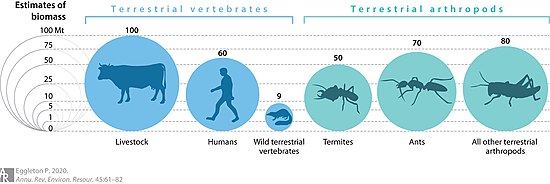
Humans and livestock make up more than 90% of the biomass of all terrestrial vertebrates, and almost as much as all insects combined.[41]
Economic and social benefits
[edit]
The value of global livestock production in 2013 has been estimated at 883 billion dollars, (constant 2005–2006 dollars).[42] However, economic implications of livestock production extend further: to downstream industry (saleyards, abattoirs, butchers, milk processors, refrigerated transport, wholesalers, retailers, food services, tanneries, etc.), upstream industry (feed producers, feed transport, farm and ranch supply companies, equipment manufacturers, seed companies, vaccine manufacturers, etc.) and associated services (veterinarians, nutrition consultants, shearers, etc.).[43]
Livestock provide a variety of food and non-food products; the latter include leather, wool, pharmaceuticals, bone products, industrial protein, and fats. For many abattoirs, very little animal biomass may be wasted at slaughter. Even intestinal contents removed at slaughter may be recovered for use as fertilizer. Livestock manure helps maintain the fertility of grazing lands. Manure is commonly collected from barns and feeding areas to fertilize cropland. In some places, animal manure is used as fuel, either directly (as in some non-Western countries), or indirectly (as a source of methane for heating or for generating electricity). In regions where machine power is limited, some classes of livestock are used as draft stock, not only for tillage and other on-farm use, but also for transport of people and goods. In 1997, livestock provided energy for between an estimated 25 and 64% of cultivation energy in the world's irrigated systems, and that 300 million draft animals were used globally in small-scale agriculture.[44]
Although livestock production serves as a source of income, it can provide additional economic values for rural families, often serving as a major contributor to food security and economic security. Livestock can serve as insurance against risk[45] and is an economic buffer (of income and food supply) in some regions and some economies (e.g., during some African droughts). However, its use as a buffer may sometimes be limited where alternatives are present,[46] which may reflect strategic maintenance of insurance in addition to a desire to retain productive assets. Even for some farmers in Western nations, livestock can serve as a kind of insurance.[47] Some crop growers may produce livestock as a strategy for diversification of their income sources, to reduce risks related to weather, markets and other factors.[48][49]
Many studies have found evidence of the social, as well as economic, importance of livestock in non-Western countries and in regions of rural poverty, and such evidence is not confined to pastoral and nomadic societies.[45][50][51][52]
Social values in developed countries can also be considerable. For example, in a study of livestock ranching permitted on national forest land in New Mexico, US, it was concluded that "ranching maintains traditional values and connects families to ancestral lands and cultural heritage", and that a "sense of place, attachment to land, and the value of preserving open space were common themes". "The importance of land and animals as means of maintaining culture and way of life figured repeatedly in permittee responses, as did the subjects of responsibility and respect for land, animals, family, and community."[53]
In the US, profit tends to rank low among motivations for involvement in livestock ranching.[54] Instead, family, tradition and a desired way of life tend to be major motivators for ranch purchase, and ranchers "historically have been willing to accept low returns from livestock production".[55]
Environmental impact
[edit]| Food Types | Greenhouse Gas Emissions (g CO2-Ceq per g protein) |
|---|---|
| Ruminant Meat | |
| Recirculating Aquaculture | |
| Trawling Fishery | |
| Non-recirculating Aquaculture | |
| Pork | |
| Poultry | |
| Dairy | |
| Non-trawling Fishery | |
| Eggs | |
| Starchy Roots | |
| Wheat | |
| Maize | |
| Legumes |
Animal husbandry has a significant impact on the world environment. It is responsible for somewhere between 20 and 33% of the fresh water usage in the world,[57] and livestock, and the production of feed for them, occupy about a third of Earth's ice-free land.[58] Livestock production is a contributing factor in species extinction, desertification,[59] and habitat destruction.[60] Meat is considered one of the prime factors contributing to the current sixth mass extinction.[61][62][63][64] Animal agriculture contributes to species extinction in various ways. Habitat is destroyed by clearing forests and converting land to grow feed crops and for animal grazing (for example, animal husbandry is responsible for up to 91% of the deforestation in the Amazon region[65]), while predators and herbivores are frequently targeted and hunted because of a perceived threat to livestock profits. The newest report released by the Intergovernmental Panel on Climate Change (IPCC) states that between the 1970s and 2000s agricultural emission increases were directly linked to an increase in livestock. The population growth of livestock (including cattle, buffalo, sheep, and goats) is done with the intention of increasing animal production, but in turn increases emissions.[66]
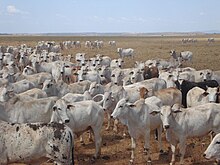
In addition, livestock produce greenhouse gases. The IPCC has estimated that agriculture (including not only livestock, but also food crop, biofuel and other production) accounted for about 10 to 12 percent of global anthropogenic greenhouse gas emissions (expressed as 100-year carbon dioxide equivalents) in 2005[67] and in 2010.[68] Cattle produce some 79 million tons of methane per day.[69][70][71] Live westock enteric methane account 30% of the overall methane emissions of the planet.[69][70][71] Livestock are responsible for 34% of all human-related emissions of nitrous oxide, through feed production and manure.[69][70][71].Best production practices are estimated to be able to reduce livestock emissions by 30%.[69][70][71]
Impacts of climate change
[edit]
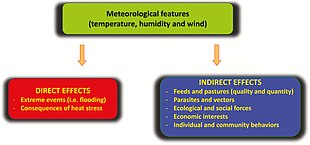
There are numerous interlinked effects of climate change on livestock rearing. This activity is both heavily affected by and a substantial driver of anthropogenic climate change due to its greenhouse gas emissions. As of 2011, some 400 million people relied on livestock in some way to secure their livelihood.[74]: 746 The commercial value of this sector is estimated as close to $1 trillion.[75] As an outright end to human consumption of meat and/or animal products is not currently considered a realistic goal,[76] any comprehensive adaptation to effects of climate change must also consider livestock.
The observed adverse impacts on livestock production include increased heat stress in all but the coldest nations.[77][78] This causes both mass animal mortality during heatwaves, and the sublethal impacts, such as lower quantity of quality of products like milk, greater vulnerability to conditions like lameness or even impaired reproduction.[74] Another impact concerns reduced quantity or quality of animal feed, whether due to drought or as a secondary impact of CO2 fertilization effect. Difficulties with growing feed could reduce worldwide livestock headcounts by 7–10% by midcentury.[74]: 748 Animal parasites and vector-borne diseases are also spreading further than they had before, and the data indicating this is frequently of superior quality to one used to estimate impacts on the spread of human pathogens.[74]
While some areas which currently support livestock animals are expected to avoid "extreme heat stress" even with high warming at the end of the century, others may stop being suitable as early as midcentury.[74]: 750 In general, sub-Saharan Africa is considered to be the most vulnerable region to food security shocks caused by the impacts of climate change on their livestock, as over 180 million people across those nations are expected to see significant declines in suitability of their rangelands around midcentury.[74]: 748 On the other hand, Japan, the United States and nations in Europe are considered the least vulnerable. This is as much a product of pre-existing differences in human development index and other measures of national resilience and widely varying importance of pastoralism to the national diet as it is an outcome of direct impacts of climate on each country.[72]
Proposed adaptations to climate change in livestock production include improved cooling at animal shelters and changes to animal feed, though they are often costly or have only limited effects.[79] At the same time, livestock produces the majority of greenhouse gas emissions from agriculture and demands around 30% of agricultural fresh water needs, while only supplying 18% of the global calorie intake. Animal-derived food plays a larger role in meeting human protein needs, yet is still a minority of supply at 39%, with crops providing the rest.[74]: 746–747 Consequently, plans for limiting global warming to lower levels like 1.5 °C (2.7 °F) or 2 °C (3.6 °F) assume animal-derived food will play a lower role in the global diets relative to now.[80] As such, net zero transition plans now involve limits on total livestock headcounts (including reductions of already disproportionately large stocks in countries like Ireland),[81] and there have been calls for phasing out subsidies currently offered to livestock farmers in many places worldwide.[82]See also
[edit]- Agribusiness
- Agroecology
- Amenable species
- Bovine spongiform encephalopathy
- California Proposition 2 (2008)
- Cryoconservation of animal genetic resources
- Cuniculture (rabbit farming)
- Leave the gate as you found it
- Livestock's Long Shadow – Environmental Issues and Options (UN report)
- Pen
- Sericulture (silkworm farming)
- Sheep husbandry
- Western Fair
- Wildlife farming
References
[edit]- ^ "livestock". Britannica.com. 15 June 2024.
- ^ "Congress Clarifies That Horses are Not "Pets," Advances Landmark Livestock Health Measures". American Horse Council. Retrieved 19 January 2019.
- ^ "Fresh Pork from Farm to Table". fsis.usda.gov.
- ^ "NASS – Census of Agriculture – Publications – 2012". USDA. Archived from the original on 22 November 2017. Retrieved 29 November 2017.
- ^ Anomaly, Jonathan (1 November 2015). "What's Wrong With Factory Farming?". Public Health Ethics. 8 (3): 246–254. doi:10.1093/phe/phu001. hdl:10161/9733. ISSN 1754-9973. PMC 9757169. PMID 36540869. S2CID 39813493.
- ^ "Livestock definition". Dictionary.com. Retrieved 23 November 2015.
- ^ "Merriam-Webster: Definition of Livestock". Merriam-Webster. Retrieved 18 January 2019.
- ^ "Agriculture: A Glossary of Terms, Programs, and Laws" (PDF). 2005. Archived from the original (PDF) on 12 February 2011. Retrieved 10 December 2011.
- ^ cbc.ca: "Police launch investigation into Aylmer Meat Packers", 28 August 2003
- ^ Larson, G.; Bradley, D. G. (2014). "How Much Is That in Dog Years? The Advent of Canine Population Genomics". PLOS Genetics. 10 (1): e1004093. doi:10.1371/journal.pgen.1004093. PMC 3894154. PMID 24453989.
- ^ Chessa, B.; Pereira, F.; Arnaud, F.; Amorim, A.; Goyache, F.; Mainland, I.; Kao, R. R.; Pemberton, J. M.; Beraldi, D.; Stear, M. J.; Alberti, A.; Pittau, M.; Iannuzzi, L.; Banabazi, M. H.; Kazwala, R. R.; Zhang, Y.-p.; Arranz, J. J.; Ali, B. A.; Wang, Z.; Uzun, M.; Dione, M. M.; Olsaker, I.; Holm, L.-E.; Saarma, U.; Ahmad, S.; Marzanov, N.; Eythorsdottir, E.; Holland, M. J.; Ajmone-Marsan, P.; Bruford, M. W.; Kantanen, J.; Spencer, T. E.; Palmarini, M. (24 April 2009). "Revealing the History of Sheep Domestication Using Retrovirus Integrations". Science. 324 (5926): 532–536. Bibcode:2009Sci...324..532C. doi:10.1126/science.1170587. PMC 3145132. PMID 19390051.
- ^ Vigne, J. D.; Zazzo, A.; Saliège, J. F.; Poplin, F.; Guilaine, J.; Simmons, A. (2009). "Pre-Neolithic wild boar management and introduction to Cyprus more than 11,400 years ago". Proceedings of the National Academy of Sciences of the United States of America. 106 (38): 16135–8. Bibcode:2009PNAS..10616135V. doi:10.1073/pnas.0905015106. PMC 2752532. PMID 19706455.
- ^ Larson, Greger; Liu, Ranran; Zhao, Xingbo; Yuan, Jing; Fuller, Dorian; Barton, Loukas; Dobney, Keith; Fan, Qipeng; Gu, Zhiliang; Liu, Xiao-Hui; Luo, Yunbing; Lv, Peng; Andersson, Leif; Li, Ning (19 April 2010). "Patterns of East Asian pig domestication, migration, and turnover revealed by modern and ancient DNA". Proceedings of the National Academy of Sciences. 107 (17): 7686–7691. Bibcode:2010PNAS..107.7686L. doi:10.1073/pnas.0912264107. PMC 2867865. PMID 20404179.
- ^ "Breeds of Livestock - Oklahoma State University". Ansi.okstate.edu. Retrieved 10 December 2011.
- ^ McTavish, E.J.; Decker, J. E.; Schnabel, R. D.; Taylor, J. F.; Hillis, D. M. (2013). "New World cattle show ancestry from multiple independent domestication events". Proc. Natl. Acad. Sci. U.S.A. 110 (15): E1398–406. Bibcode:2013PNAS..110E1398M. doi:10.1073/pnas.1303367110. PMC 3625352. PMID 23530234.
- ^ "History of chickens – India and China". 12 June 2017.
- ^ a b Webster, John (2013). Animal Husbandry Regained: The Place of Farm Animals in Sustainable Agriculture. Routledge. pp. 4–10. ISBN 978-1-84971-420-4.
- ^ Blench, Roger (17 May 2001). 'You can't go home again' – Pastoralism in the new millennium (PDF). Overseas Development Institute. p. 12. Archived from the original (PDF) on 1 February 2012. Retrieved 29 April 2018.
- ^ Starrs, Paul F. (2000). Let the Cowboy Ride: Cattle Ranching in the American West. JHU Press. pp. 1–2. ISBN 978-0-8018-6351-6.
- ^ Levinson, David; Christensen, Karen (2003). Encyclopedia of Community: From the Village to the Virtual World. Sage. p. 1139. ISBN 978-0-7619-2598-9.
- ^ Rebanks, James (2015). The Shepherd's Life. Penguin: Random House. p. 286. ISBN 978-0141-97936-6.
- ^ Silbergeld, Ellen K; Graham, Jay; Price, Lance B (2008). "Industrial food animal production, antimicrobial resistance, and human health". Annual Review of Public Health. 29: 151–69. doi:10.1146/annurev.publhealth.29.020907.090904. PMID 18348709.
- ^ Meyer, Vernon M.; Driggers, L. Bynum; Ernest, Kenneth; Ernest, Debra. "Swine Growing-Finishing Units" (PDF). Pork Industry handbook. Purdue University Cooperative Extension Service. Retrieved 17 May 2017.
- ^ Blount, W.P. (2013). Intensive Livestock Farming. Elsevier. pp. 360–62. ISBN 978-1-4831-9565-0.
- ^ Northern Daily Leader, 20 May 2010, Dogs mauled 30 sheep (and killed them), p.3, Rural Press
- ^ Simmons, Michael (10 September 2009). "Dogs seized for killing sheep - Local News - News - General - The Times". Victorharbortimes.com.au. Archived from the original on 11 January 2012. Retrieved 10 December 2011.
- ^ "EPRUMA | Responsible Use of Animal Medicines". www.epruma.eu. Retrieved 8 February 2020.
- ^ "Classical swine fever" (PDF). The Center for Food Security and Public Health. Retrieved 20 May 2017.
- ^ "Scrapie Fact Sheet". National Institute for Animal Agriculture. 2001. Archived from the original on 12 December 2020. Retrieved 20 May 2017.
- ^ "Foot-and-mouth". The Cattle Site. Retrieved 20 May 2017.
- ^ "feed (agriculture) | Antibiotics and other growth stimulants". Britannica.com. Retrieved 29 April 2018.
- ^ Fraser, Douglas (14 February 2017). "Scottish salmon farming's sea lice 'crisis'". BBC. Retrieved 20 May 2017.
- ^ "Parasite control". Animal Health Ireland. Archived from the original on 14 May 2017. Retrieved 20 May 2017.
- ^ Mbow, C.; Rosenzweig, C.; Barioni, L. G.; Benton, T.; et al. (2019). "Chapter 5: Food Security" (PDF). Special Report on climate change and land (SRCCL).
- ^ Bonser, K. J. (1972). The Drovers. Who They Were and How They Went: An Epic of the English Countryside. Country Book Club.
- ^ Chambers, Philip G.; Grandin, Temple; Heinz, Gunter; Srisuvan, Thinnarat (2001). "Guidelines for Humane Handling, Transport and Slaughter of Livestock | CHAPTER 6: Transport of livestock". Food and Agriculture Organization. Archived from the original on 12 June 2009. Retrieved 29 April 2018.
- ^ "Worker dies, hundreds sick as Cargill temporarily closes meat-processing plant at centre of COVID-19 outbreak". CBC. 21 April 2020.
- ^ a b "What led to Alberta's biggest outbreak? Cargill meat plant's hundreds of COVID-19 cases". CBC. 19 April 2020.
- ^ Markets from research to outcomes Archived 1 May 2014 at WebCite, Farming Matters, Challenge Program on Water and Food, June 2013
- ^ Australian Screen: Agricultural shows
- ^ a b Eggleton, Paul (17 October 2020). "The State of the World's Insects". Annual Review of Environment and Resources. 45 (1): 61–82. doi:10.1146/annurev-environ-012420-050035. ISSN 1543-5938.
- ^ FAOSTAT. (Statistical database of the Food and Agriculture Organization of the United Nations.) http://faostat3.fao.org/ Archived 20 October 2016 at the Wayback Machine
- ^ "USDA ERS - Ag and Food Sectors and the Economy". www.ers.usda.gov. Retrieved 2024-10-08.
- ^ de Haan, Cees; Steinfeld, Henning; Blackburn, Harvey (1997). Livestock & the environment: finding a balance. European Commission Directorate-General for Development.
- ^ a b Swanepoel, F., A. Stroebel and S. Moyo. (eds.) 2010. The role of livestock in developing communities: Enhancing multifunctionality. African Sun Media.
- ^ Fafchamps, Marcel; Udry, Christopher; Czukas, Katherine (1998). "Drought and saving in West Africa: are livestock a buffer stock?" (PDF). Journal of Development Economics. 55 (2): 273–305. CiteSeerX 10.1.1.198.7519. doi:10.1016/S0304-3878(98)00037-6. ISSN 0304-3878. Retrieved 12 May 2018.
- ^ Johannesen, Anne Borge; Skonhoft, Anders (2011). "Livestock as Insurance and Social Status: Evidence from Reindeer Herding in Norway" (PDF). Environmental and Resource Economics. 48 (4): 679–694. Bibcode:2011EnREc..48..679J. doi:10.1007/s10640-010-9421-2. ISSN 0924-6460. S2CID 54050586. Retrieved 12 May 2018.
- ^ Bell, Lindsay W.; Moore, Andrew D. (2012). "Integrated crop–livestock systems in Australian agriculture: Trends, drivers and implications". Agricultural Systems. 111: 1–12. Bibcode:2012AgSys.111....1B. doi:10.1016/j.agsy.2012.04.003. ISSN 0308-521X. Retrieved 12 May 2018.
- ^ Kandulu, John M.; Bryan, Brett A.; King, Darran; Connor, Jeffery D. (2012). "Mitigating economic risk from climate variability in rain-fed agriculture through enterprise mix diversification". Ecological Economics. 79: 105–112. Bibcode:2012EcoEc..79..105K. doi:10.1016/j.ecolecon.2012.04.025. ISSN 0921-8009. Retrieved 12 May 2018.
- ^ Bettencourt, Elisa Maria Varela; Tilman, Mário; Henriques, Pedro Damião de Sousa; Narciso, Vanda; Carvalho, Maria Leonor da Silva (2013), The Economic and Sociocultural Role of Livestock in the Wellbeing of Rural Communities of Timor-Leste, hdl:10174/9347
- ^ Khan, Nizamuddin; Rehman, Anisur; Salman, Mohd. Sadiq (2013). "Impactul creșterii animalelor asupra dezvoltării socio-economice în Nordul Indiei". Forum Geografic (in Romanian). XII (1): 75–80. doi:10.5775/fg.2067-4635.2013.084.i. ISSN 1583-1523. Retrieved 12 May 2018.
- ^ Ali, A.; Khan, M.A. (2013). "Livestock ownership in ensuring rural household food security in Pakistan" (PDF). J. Animal Plant Sci. 23 (1): 313–318. ISSN 1018-7081. Retrieved 12 May 2018.
- ^ McSweeney, A. M and C. Raish. 2012. Social, cultural and economic aspects of livestock ranching on the Santa Fe and Carson National Forests. USDA Forest Service RMRS-GTR 276.
- ^ Gentner, B.J.; Tanaka, J.A. (2006). "Classifying federal public land grazing permittees". Journal of Range Management. 55 (1). doi:10.2458/azu_jrm_v55i1_gentner. ISSN 0022-409X.
- ^ Torell, L. Allen; Rimbey, Neil R.; Tanaka, John A.; Bailey, Scott A. (2001). "THE LACK OF A PROFIT MOTIVE FOR RANCHING: IMPLICATIONS FOR POLICY ANALYSIS". In Torell, L. A.; Bartlett, E. T.; Larranaga, R. (eds.). Current issues in rangeland economics. Proc. Symp. Western Regional Coordinating Committee on Rangeland Economics: WCC-55. N. M. State Univ. Res. Rep. Vol. 737. Archived from the original on 19 December 2018. Retrieved 30 November 2018.
- ^ Michael Clark; Tilman, David (November 2014). "Global diets link environmental sustainability and human health". Nature. 515 (7528): 518–522. Bibcode:2014Natur.515..518T. doi:10.1038/nature13959. ISSN 1476-4687. PMID 25383533. S2CID 4453972.
- ^ Mekonnen, Mesfin M.; Arjen Y. Hoekstra (2012). "A Global Assessment of the Water Footprint of Farm Animal Products" (PDF). Water Footprint Network. Archived from the original (PDF) on 2015-03-11. Retrieved 2018-04-01.
- ^ "Livestock a major threat to environment". Food and Agriculture Organizations of the United Nations. Archived from the original on 2008-03-28. Retrieved 2018-04-01.
- ^ Whitford, Walter G. (2002). Ecology of desert systems. Academic Press. p. 277. ISBN 978-0-12-747261-4.
- ^ "Biodiversity Decline". Annenberg Learner. Retrieved 8 February 2020.
- ^ Morell, Virginia (2015). "Meat-eaters may speed worldwide species extinction, study warns". Science. doi:10.1126/science.aad1607.
- ^ Machovina, B.; Feeley, K. J.; Ripple, W. J. (2015). "Biodiversity conservation: The key is reducing meat consumption". Science of the Total Environment. 536: 419–431. Bibcode:2015ScTEn.536..419M. doi:10.1016/j.scitotenv.2015.07.022. PMID 26231772.
- ^ Williams, Mark; Zalasiewicz, Jan; Haff, P. K.; Schwägerl, Christian; Barnosky, Anthony D.; Ellis, Erle C. (2015). "The Anthropocene Biosphere". The Anthropocene Review. 2 (3): 196–219. Bibcode:2015AntRv...2..196W. doi:10.1177/2053019615591020. S2CID 7771527.
- ^ Smithers, Rebecca (5 October 2017). "Vast animal-feed crops to satisfy our meat needs are destroying planet". The Guardian. Retrieved 3 November 2017.
- ^ Margulis, Sergio (2003). Causes of Deforestation of the Brazilian Rainforest. World Bank Working Papers. Washington: World Bank Publications. doi:10.1596/0-8213-5691-7. ISBN 978-0-8213-5691-3.
- ^ IPCC. (2022). Chapter 7: Agriculture, Forestry, and Other Land Uses. ICPCC AR6 WGII. 7-34. https://report.ipcc.ch/ar6wg3/pdf/IPCC_AR6_WGIII_FinalDraft_Chapter07.pdf Archived 2022-10-10 at the Wayback Machine.
- ^ Intergovernmental Panel on Climate Change. 2007. Climate change 2007, Mitigation of climate change. Fourth Assessment Report
- ^ Intergovernmental Panel on Climate Change. 2014. Climate change 2014, Mitigation of climate change. Fifth Assessment Report.
- ^ a b c d "Global emissions from livestock in 2015". FAO - GLEAM v3.0 dashboard.
- ^ a b c d Reducing enteric methane for improving food security and livelihoods. FAO. 2016.
- ^ a b c d Tackling Climate Change through Livestock. Rome: FAO. 2013. ISBN 9789251079201.
- ^ a b Godber, Olivia F.; Wall, Richard (1 April 2014). "Livestock and food security: vulnerability to population growth and climate change". Global Change Biology. 20 (10): 3092–3102. Bibcode:2014GCBio..20.3092G. doi:10.1111/gcb.12589. PMC 4282280. PMID 24692268.
- ^ Lacetera, Nicola (2019-01-03). "Impact of climate change on animal health and welfare". Animal Frontiers. 9 (1): 26–31. doi:10.1093/af/vfy030. ISSN 2160-6056. PMC 6951873. PMID 32002236.
- ^ a b c d e f g Kerr R.B., Hasegawa T., Lasco R., Bhatt I., Deryng D., Farrell A., Gurney-Smith H., Ju H., Lluch-Cota S., Meza F., Nelson G., Neufeldt H., Thornton P., 2022: Chapter 5: Food, Fibre and Other Ecosystem Products. In Climate Change 2022: Impacts, Adaptation and Vulnerability [H.-O. Pörtner, D.C. Roberts, M. Tignor, E.S. Poloczanska, K. Mintenbeck, A. Alegría, M. Craig, S. Langsdorf, S. Löschke,V. Möller, A. Okem, B. Rama (eds.)]. Cambridge University Press, Cambridge, United Kingdom and New York, NY, US, pp. 1457–1579 |doi=10.1017/9781009325844.012
- ^ "FAOStat". Archived from the original on 2016-10-20. Retrieved 12 June 2023.
- ^ Rasmussen, Laura Vang; Hall, Charlotte; Vansant, Emilie C.; Braber, Bowie den; Olesen, Rasmus Skov (17 September 2021). "Rethinking the approach of a global shift toward plant-based diets". One Earth. 4 (9): 1201–1204. Bibcode:2021OEart...4.1201R. doi:10.1016/j.oneear.2021.08.018. S2CID 239376124.
- ^ Zhang, Jintao; You, Qinglong; Ren, Guoyu; Ullah, Safi; Normatov, Inom; Chen, Deliang (24 January 2023). "Inequality of Global Thermal Comfort Conditions Changes in a Warmer World". Earth's Future. 11 (2): e2022EF003109. Bibcode:2023EaFut..1103109Z. doi:10.1029/2022EF003109. S2CID 256256647.
- ^ Liu, Weihang; Zhou, Junxiong; Ma, Yuchi; Chen, Shuo; Luo, Yuchuan (3 February 2024). "Unequal impact of climate warming on meat yields of global cattle farming". Communications Earth and Environment. 5 (1): 65. Bibcode:2024ComEE...5...65L. doi:10.1038/s43247-024-01232-x.
- ^ Schauberger, Günther; Mikovits, Christian; Zollitsch, Werner; Hörtenhuber, Stefan J.; Baumgartner, Johannes; Niebuhr, Knut; Piringer, Martin; Knauder, Werner; Anders, Ivonne; Andre, Konrad; Hennig-Pauka, Isabel; Schönhart, Martin (22 January 2019). "Global warming impact on confined livestock in buildings: efficacy of adaptation measures to reduce heat stress for growing-fattening pigs". Climatic Change. 156 (4): 567–587. Bibcode:2019ClCh..156..567S. doi:10.1007/s10584-019-02525-3. S2CID 201103432.
- ^ Roth, Sabrina K.; Hader, John D.; Domercq, Prado; Sobek, Anna; MacLeod, Matthew (22 May 2023). "Scenario-based modelling of changes in chemical intake fraction in Sweden and the Baltic Sea under global change". Science of the Total Environment. 888: 2329–2340. Bibcode:2023ScTEn.88864247R. doi:10.1016/j.scitotenv.2023.164247. PMID 37196966. S2CID 258751271.
- ^ Lisa O'Carroll (3 November 2021). "Ireland would need to cull up to 1.3 million cattle to reach climate targets". The Guardian. Retrieved 12 June 2023.
- ^ "just-transition-meat-sector" (PDF).
External links
[edit]- Better Lives Through Livestock by ILRI
- Livestock - New South Wales Government
- Havana Livestock Fair (Photo Feature) - Havana Times, 19 October 2010
- A Short History of Livestock Production
- Have we reached ‘peak meat’? Why one country is trying to limit its number of livestock. The Guardian. 16 January 2023




